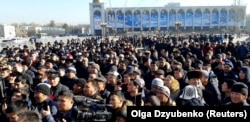China is investing heavily in Kyrgyzstan’s underfunded media sector, expanding its state-run outlets and building partnerships with local companies in an effort to shape the information landscape in the Central Asian country, according to a new report.
The study of Chinese inroads into Kyrgyz media, which was released on August 25 by the Organization for Security and Cooperation in Europe (OSCE) Academy in Bishkek, is part of a multiyear research project into the tactics used by Chinese state actors to create positive coverage about China, spread negative political talking points about the United States and the West, and suppress or drown out stories about China’s interests in Central Asia, such as concerns over an internment-camp system for Uyghurs and other Muslim minorities in its neighboring Xinjiang Province.
“Money talks, and that’s a problem because [Kyrgyzstan’s] media sector is very underfunded,” Niva Yau, senior researcher at the OSCE Academy and the author of the report, told RFE/RL. “[China] has lots of money to invest and spend, and it can use that to build relationships and control access and opportunities that can restrict negative reports and flood the information space with [positive stories] about China.”
Among some of the key strategies documented by Yau for influencing local narratives, she found the most common were: paid content within Kyrgyz media and funding partnerships; expanding the presence of Chinese media in Kyrgyzstan; and relying heavily on social media networks and online influencers to help spread messages.
The report also notes that the Chinese Embassy in Bishkek plays an important role in coordinating local content by arranging free reporting trips, offering funding, and consultations -- all incentives that local journalists named when surveyed as being factors in the publishing of favorable stories and the withholding of negative ones.
“This world is all very murky and gray,” said Yau. “There is lots of clumsiness to observe on the Chinese side, but it is still growing and also adapting, especially on social media where there is lots of targeted content and ads across various platforms that can be difficult to trace.”
Long-Term View
Central Asia, which borders western China, has been a strategic priority for Beijing in recent decades as it has sought to build up its political and economic influence with deeper ties to local elites, militaries, and investing through its multibillion Belt and Road Initiative (BRI) infrastructure project.
But Yau said her research highlights how Chinese engagement and influence in Central Asia -- and particularly in Kyrgyzstan -- is no longer confined to these areas and is also aiming to build ties to a broader section of society.
Control over the information space has been a key part of the Chinese government’s control at home and this has extended to foreign countries as Beijing’s footprint has expanded abroad. China’s leadership has been transparent in outlining these goals in official documents and has identified neighboring regions and the developing world as a whole as an area of opportunity.
China has been spearheading agreements with Kyrgyz media companies since the early 2000s. These deals have ranged from arrangements that allow for local outlets to reprint Chinese content as they wish to more stringent commitments about reproducing domestic and world news reporting, as well as producing specific content for lifestyle, technology, finance, and travel.
According to a list published by the Kyrgyz Foreign Ministry in 2022, there are three Chinese state-run media companies registered in the country, which include Xinhua, Wen Wei Po, and the Silk Road Observer. Two more -- Dolon TV and Land Bridge -- operate in Kyrgyzstan as private Chinese media companies.
Yau said it is still difficult to determine the overall effectiveness of this Chinese media strategy, but preliminary research carried out by her and the OSCE Academy, including a mass phone survey, found that it was successful in shaping perceptions around internment camps in Xinjiang.
International researchers and Western governments estimate that China has detained more than 1 million Uyghurs, ethnic Kazakhs, Kyrgyz, and other groups in a vast camp system in Xinjiang. Beijing has defended the camps as necessary for fighting extremism in the region and denied any human rights violations, although credible evidence exists of torture, forced sterilization, and other abuses.
According to Yau’s research, a great deal of the trips provided to Kyrgyz journalists have been to take them to Xinjiang, where they were shown idealized depictions of the region, complete with prosperous villages and development projects. These stories are then published locally by Kyrgyz outlets, which Yau said serves to confuse audiences and create distrust over other reporting about the camp system and accompanying abuses.
“It’s a strategy of two things for coverage around Xinjiang: The first tactic is to suppress media attention as much as possible, and the other is to produce other stories that can confuse audiences because it is so [polarizing] compared to other information available,” she said. “At the end of the day, I think that’s where it’s most effective. Maybe it doesn’t convince anyone, but it can make them suspicious of these [accusations] against the Chinese government.”
Inroads And Obstacles
While the report documents how China’s media strategy has been effective in Kyrgyzstan, taking advantage of the country’s relatively free media space, Yau noted there are still difficulties when it comes to adapting its approach to local preferences.
“[China] is quite immature when it comes to global media. They just copy and paste that model [from home] when they go overseas and in many cases refuse to listen to the local people that work for them,” Yau said.
In one anecdote, a Kyrgyz producer told her he had been approached by a Chinese delegation that wanted to jointly produce a movie for local audiences. He said they pitched him a film about a Chinese man coming to work in Kyrgyzstan, where he falls in love with a Kyrgyz woman. When the local producer told them that this would be poorly received and seen as provocative, he said he was shocked to learn that the Chinese delegation was completely unaware of anti-China protests in the country and that interracial marriage had been a factor in rising Sinophobia in some areas.
Another obstacle that China faces in Kyrgyzstan is a lack of enthusiasm from local employees for working with Chinese entities and projects. Yau surveyed multiple current and former Kyrgyz who worked for or with Chinese media and, while they said they were attracted by better pay, many acknowledged they knew they were producing propaganda or even outright disinformation.
“For many people, their heart's not in it. It’s something pragmatic because there’s no other option,” Yau said. “Given any other opportunity, they likely wouldn’t choose China as a partner, which I think is [representative] of the wider perception of China in this country.”














